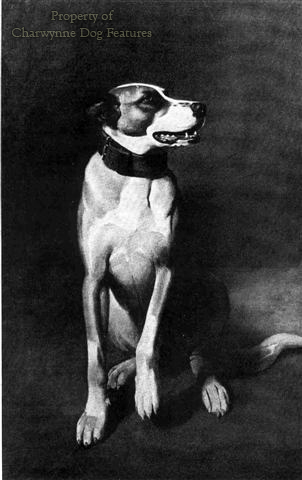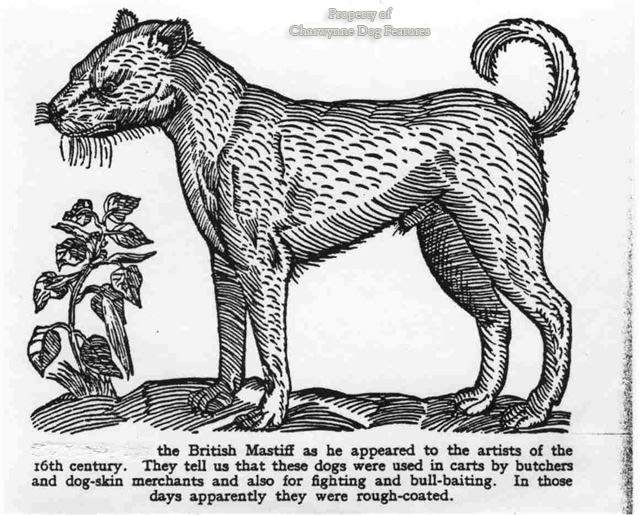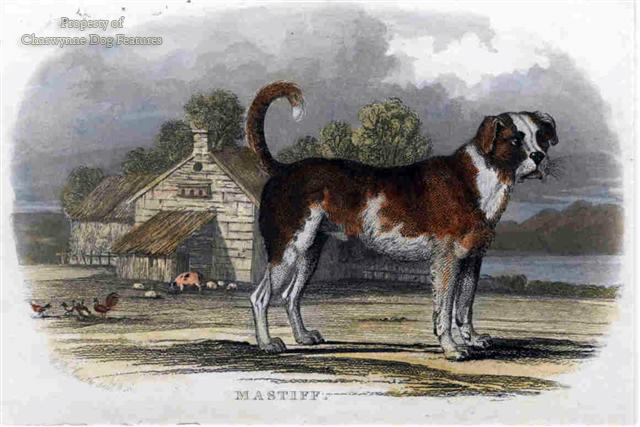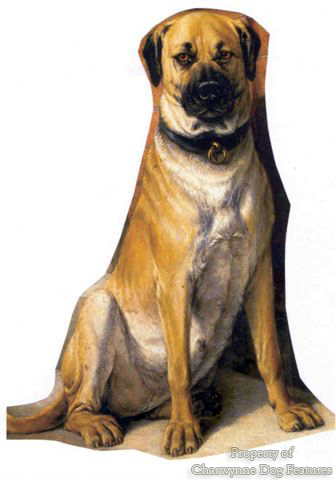432 Mastiff of England
HUNTING DOWN THE MASTIFFS OF ENGLAND
by David Hancock
 Any number of books on the surviving mastiff breeds tell us plenty about the Deutsche Dogge, the German Mastiff or Great Dane, and the French Mastiff, the Dogue de Bordeaux. But not many tell us the story of the Englische Dogge, most prized hunting mastiff in Central Europe in medieval times. Until the thirteenth century in England, a mastiff-type dog was called a 'docga', an Old English word, still retained on mainland Europe as dogge in Germany, dogue in France and dogo in Spain. The master-engraver Riedinger portrayed the Englische Dogge at the end of the 17th century. No one claimed them as a breed, dogs then being bred for function not form, and never to a closed gene pool.
Any number of books on the surviving mastiff breeds tell us plenty about the Deutsche Dogge, the German Mastiff or Great Dane, and the French Mastiff, the Dogue de Bordeaux. But not many tell us the story of the Englische Dogge, most prized hunting mastiff in Central Europe in medieval times. Until the thirteenth century in England, a mastiff-type dog was called a 'docga', an Old English word, still retained on mainland Europe as dogge in Germany, dogue in France and dogo in Spain. The master-engraver Riedinger portrayed the Englische Dogge at the end of the 17th century. No one claimed them as a breed, dogs then being bred for function not form, and never to a closed gene pool.
But how did such powerful dogs come into being in England? The myth that the Romans found mastiffs here when they reached England has long been exposed; it is however still being repeated by the lazier writers and research-free breed historians. In RA Harcourt's 'The Dog in Prehistoric and Early Historic Britain' of 1974, he sets out his painstaking examination of all the bones of dogs unearthed in the immediate pre-Roman period. He found no massive, heavy-headed dogs but plenty of medium-sized hounds. But an examination of dog bones from Romano-British times revealed the presence here then of much larger dogs. The cavalry of the Romans invading Britain was provided by a steppe people, the Alans, famed for their mastery of the horse, for the quality of their horses and for their formidable hunting dogs, the Alauntes.
Marcus Aurelius, according to Sulimirski, sent 5,500 Alan horsemen to Britain, where they protected, amongst other places, Hadrian's Wall. The rivers Avon in Hampshire and the Alne in Northumberland were both once called the Alaun, such was their legacy. Chaucer, in the fourteenth century, made reference to Alauntes as big as steers. The word mastiff was not in general use in Britain until the end of the eighteenth century. The Middle English word bandogge was used before then. Dictionaries often give bandogge the definition of tied-up or tethered yard-dog. But it refers in fact to a fierce mastiff-like dog secured, in the hunting field, on a leash or quick-release collar, until needed as a catch-dog. In Old High German a bant is a hound's leash and a huntbant is a hound's collar. There are scores of portrayals of tethered catch-dogs or bandogges in the hunting field in medieval engravings and post-medieval paintings.
 Alauntes were famous in France, as De Foix's The Master of Game of 1304 reveals, but as he indicates, they were types of strong-headed seizing dogs, not one breed. Hunters in medieval times did not seek breeds but developed types for specialist functions. In Central Europe the zwic-darm, literally a tucked-up seizing dog, resembled a mastiff-greyhound cross; a trip-hund was a heavy boarhound, a swinruede was a catch-dog for use on boar. De Foix described the mastiff, separately from the Alaunte, as a powerful hound. The Alans settled in Spain around 800AD; the broad-mouthed Iberian breeds described as Filas and Perro de Presas (meaning gripping or holding dogs) emerging subsequently. Such dogs had strong heads but not short muzzles. I suspect that strapping hunting mastiffs were often crossed with Alauntes in the timeless pursuit of an improved hunting dog, especially in the hunting of big game such as wild bull, stag, boar, bison, bear and auroch.
Alauntes were famous in France, as De Foix's The Master of Game of 1304 reveals, but as he indicates, they were types of strong-headed seizing dogs, not one breed. Hunters in medieval times did not seek breeds but developed types for specialist functions. In Central Europe the zwic-darm, literally a tucked-up seizing dog, resembled a mastiff-greyhound cross; a trip-hund was a heavy boarhound, a swinruede was a catch-dog for use on boar. De Foix described the mastiff, separately from the Alaunte, as a powerful hound. The Alans settled in Spain around 800AD; the broad-mouthed Iberian breeds described as Filas and Perro de Presas (meaning gripping or holding dogs) emerging subsequently. Such dogs had strong heads but not short muzzles. I suspect that strapping hunting mastiffs were often crossed with Alauntes in the timeless pursuit of an improved hunting dog, especially in the hunting of big game such as wild bull, stag, boar, bison, bear and auroch.
Strong-headed, square-skulled, broad-mouthed dogs are notoriously difficult to breed uniformly, even in a closed gene pool. Alauntes varied from the powerful zwic-darm type of mastiff-greyhound blend down to the Alauntes of the Butcheries or smaller heavier-headed seizing dogs. In England, we featured the taller hunting mastiff, once expeditated or de-toed to prevent them harassing game, the more compact sturdier guarding breed, once utilised as nightdogs, and the even smaller baiting dogs, favoured by butchers as holding dogs with cattle. In such ways did the modern breeds of Mastiff, Bullmastiff and Bulldog develop separate identities. But the Mastiff and the Bulldog have long been developed by modern breeders away from their classic phenotype.
I do not believe that breeders of today have kept faith with the heritage behind the magnificent breeds handed down to them by those who used the breeds of Mastiff, Bullmastiff and Bulldog and designed them for that use. Any observer of giant badly-constructed Mastiffs and muzzle-less unathletic Bulldogs in our show rings cannot deny this. I agree with the under-valued Scottish writer, James Watson, in his The Dog Book (in two large volumes) of 1906, on the modern Mastiff. He considers that this breed was wholly reconstructed in the 19th century with the use of Alpine Mastiff, Great Dane and Tibetan Mastiff blood. The bizarre pursuit of giant dogs too contributed. The Mastiff of the 18th century was more the size of the Bullmastiff. Dr J Sidney Turner, a well-known and respected Mastiff breeder of the 1890s, had only one of his top seven dogs exceeding 29 inches at the withers.
 Wynn, the acknowledged Mastiff expert of the 19th century, wrote: "Many good dogs are only 28 or 29 inches." The introduction of outside blood in any breed has long-lasting effects. When working and living in Germany on three separate occasions and researching the Great Dane there, it was apparent that boarhounds in the medieval hunt were around two feet at the shoulder. It was the introduction of Suliot Dog blood, giant hounds from Epirus, used as outpost sentries in the Austrian army and as parade dogs by German regiments, which raised the height of the German boarhound. I suspect that no boarhound would last long in the medieval boar hunt if it lacked both agility and coordination. No successful coursing Greyhound has ever been 30 inches at the withers.
Wynn, the acknowledged Mastiff expert of the 19th century, wrote: "Many good dogs are only 28 or 29 inches." The introduction of outside blood in any breed has long-lasting effects. When working and living in Germany on three separate occasions and researching the Great Dane there, it was apparent that boarhounds in the medieval hunt were around two feet at the shoulder. It was the introduction of Suliot Dog blood, giant hounds from Epirus, used as outpost sentries in the Austrian army and as parade dogs by German regiments, which raised the height of the German boarhound. I suspect that no boarhound would last long in the medieval boar hunt if it lacked both agility and coordination. No successful coursing Greyhound has ever been 30 inches at the withers.
Our Bulldog too has been spoiled by outside blood. I have been accused of propounding an individual view on the use of Pug blood in the Bulldog. Six different Victorian and Edwardian writers stated that this cross occurred; I have merely restated their joint view. Depictions of Bulldogs before this cross showed dogs with ample muzzle length, distinct leg length and a far less squat build. In a free society dog breeders can breed whatever they like; but they cannot claim to be perpetuating a breed if it is quite unlike its own ancestors. The Bullmastiff too is veering away from its prototypal models, many looking like fawn American Bulldogs.
Bullmastiff fanciers revere the pioneer breeder SE Moseley and then totally ignore his advice! In Frank Barton's The Kennel Encyclopedia of 1930, Moseley is quoted as saying: "After thirty  years' experience in breeding and training, I see no reason to depart widely from the type set by those grand old dogs of the past, 'Thorneywood Terror', 'Osmaston Viper' and 'Shireland Vindictive'." These three famous early Bullmastiffs each weighed around 90lbs, had good jaw length and little or no wrinkle. These three early Bullmastiffs, two of them extremely effective gamekeepers' nightdogs, would go unplaced in our contemporary show rings. An outstanding contemporary dog like Wyburn Nightcap, 28" at the withers, athletic, unwrinkled and strong jawed but not not Pug-faced, would have been treasured as a nightdog.
years' experience in breeding and training, I see no reason to depart widely from the type set by those grand old dogs of the past, 'Thorneywood Terror', 'Osmaston Viper' and 'Shireland Vindictive'." These three famous early Bullmastiffs each weighed around 90lbs, had good jaw length and little or no wrinkle. These three early Bullmastiffs, two of them extremely effective gamekeepers' nightdogs, would go unplaced in our contemporary show rings. An outstanding contemporary dog like Wyburn Nightcap, 28" at the withers, athletic, unwrinkled and strong jawed but not not Pug-faced, would have been treasured as a nightdog.
Our native mastiff breeds are testament to the fact that once a breed loses its function it is prey to every misbegotten human whim imaginable. Sadly the public assume that breed fanciers know their breed and accept immobile Mastiffs, waddling Bulldogs and increasingly short-faced wrinkled Bullmastiffs as desirable perpetuations of treasured historically-correct breed type. The mastiff breeds were once the big game hunters, heavy hounds used to pull down big quarry. Any dog prepared to attack an auroch or seize an elk has to be something special. Before the invention of firearms, such dogs' success made the difference between the hunter eating or starving. Yet natural historians and anthropologists with no knowledge of hunting still try to convince us of how effective primitive spears and arrows were in the hunting field.
Truly, if you had to survive by hunting big game with close quarter combat weapons or by employing huge ferocious recklessly brave hounds, which would you choose? Scholars have for me routinely undervalued hunting dogs. I recently read a hefty tome on medieval Germany; the word hunting was not even listed in the lengthy index. Yet in the Middle Ages the nobility of Central Europe was obsessed with hunting; King Augustus II himself killed more than 400 boar during one extended hunt in Saxony. Without the use of big brave dogs how likely would that achievement have been? When the asteroid hits Mother Earth and we are all hunters once again, where will huge athletic powerful hunting dogs be found? Moral vanity from town-dwellers and ill-thought-through laws like the Dangerous Dogs Act will soon have wiped them all out. Unless, of course, the breeders of purebred dogs beat them to it!